News
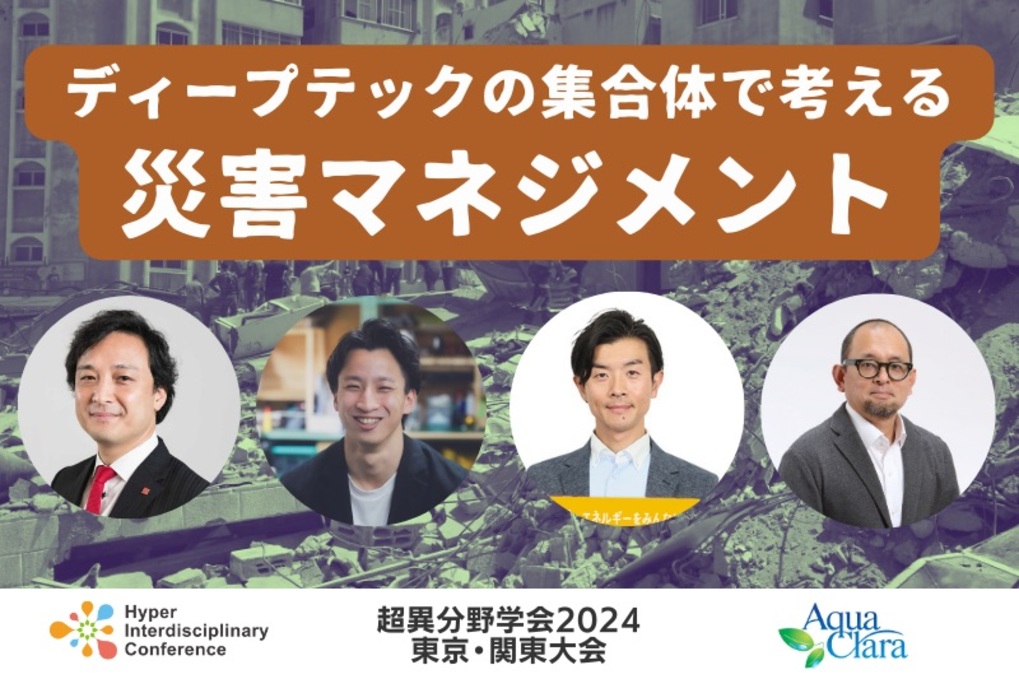
The session "Disaster Management in Deep Tech Aggregation" was held at the Tokyo-Kanto Conference of the Association for Hyperdisciplinary Research in March 2024. Through this session, the concept of the Liverness Resilience Project was revealed.
When a catastrophe strikes, it is critical that a city be resilient and resilient. However, even in situations where disaster management is needed, few communities are able to act quickly to restore infrastructure and daily life. Can we create a collective team of deep techs to accelerate disaster management? The speakers, who actually have deep tech that can contribute to the disaster area, will discuss how to do so.
Transforming Water Infrastructure from Construction to Manufacturing
RIVANES Yukihiro Maru Ladies and gentlemen, out of the blue, what would you do if an earthquake occurred here and now? Would you hide under your chair? Secure a way out? That's about the only thing that comes to mind immediately, isn't it? The Noto Peninsula earthquake that occurred on New Year's Day this year also struck unexpectedly at a moment when people were having a good time.
What is important after a catastrophe is whether or not a city is resilient. But in reality, are there communities in Japan that can act quickly to restore infrastructure and daily life? The Noto Peninsula earthquake does not seem to have gone well in this area.
Each of you who are speaking today has deep tech that can contribute to the disaster area. I look forward to discussing disaster management with these members. First of all, Mr. Maeda of WOTA, who just returned yesterday from the disaster area in Noto, please introduce yourself.
Mr. Yosuke Maeda, WOTA My name is Maeda of WOTA. We are a company founded with the aim of "solving the world's water problems," but it is a high hurdle for a venture company to suddenly start working on water for daily use, and our technology is still in its infancy. And above all, one of the most familiar water problems we faced was the widespread shutdown of water supply in the event of a disaster. That is why we initially aimed to create a product for water problems during disasters. Then, in 2018, the torrential rains hit western Japan. At that time, we rushed to the site with a water purification system we had made as a prototype and were able to provide warm showers to those who were unable to take a bath for about two weeks.
This led us to begin working on the issue of wide-area water shutoffs in the event of a disaster. Because of the limitations of the prototype, we spent about a year commercializing the WOTA BOX, a compact and easy-to-operate water reclamation and treatment system. With this system, it is possible to filter and disinfect locally collected water and recycle more than 98% of it.
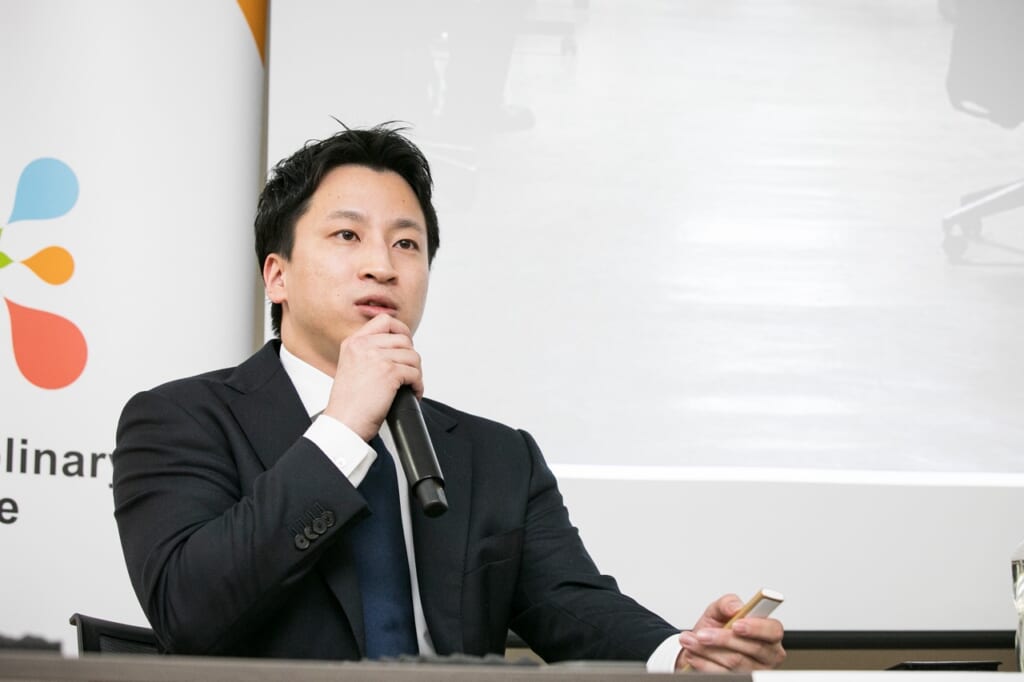
Mr. Yosuke Maeda Representative Director and CEO, WOTA Inc. Born in Tokushima Prefecture. Graduated from the University of Tokyo, Faculty of Engineering, Department of Architecture, and completed a master's degree in architecture at the Graduate School of Engineering, the same university. Started studying biology as an elementary school student, and became interested in water issues in junior high school, which led him to conduct research on water treatment in high school. At university, he studied urban infrastructure and the living environment of slums in developing countries, and at graduate school he studied housing facilities (water supply, drainage, and sanitation). As CEO of WOTA, he aims for structural solutions to water problems.
Since then, we have visited every time there has been a major disaster, both in Japan and overseas, to install water reclamation systems. After the recent Noto Peninsula earthquake, we worked with the Ishikawa Prefectural Government from January 1, the day the earthquake occurred, and by the end of January we had covered the entire area of the Noto Peninsula where water was cut off, providing access to bathing for approximately 10,000 people daily. The water outage in Noto has been prolonged, and it is difficult for employees alone to continue to maintain and manage the system. Therefore, we established an "autonomous operation" model in which local residents also cooperate. Some of the people responsible for the operation are third-year junior high school students. This time, we were able to confirm that these people can operate the "WOTA BOX.
Our activities during the Noto Peninsula earthquake were introduced in Prime Minister Kishida's policy speech at the National Diet, and many people became aware of the water problem in times of disaster. However, we believe that we should not stop here. Our current system can only cover about 10,000 people. For example, if an earthquake were to hit the Tokyo metropolitan area, according to government estimates, about 1 to 3.6 million people would be without water even after one month. In response to this, we are currently almost unprepared for water use.
Currently, water and sewage systems are connected by pipelines between large treatment facilities and residences, but this can cause water shortages in the event of a disaster and is expensive to maintain and manage. Therefore, our long-term mission is to promote small-scale decentralized infrastructure that circulates water on a household basis. To this end, we plan to start mass production of a "small-scale decentralized water circulation system" for residential use this year.
Demonstration tests of this system have already begun, and in Japan it is being used in depopulated areas in Ehime Prefecture. In addition, several municipalities are considering the introduction of this system in the reconstruction of the Noto Peninsula. This is because rebuilding water and sewage pipes in the same way as before would take a lot of time and money. Even so, if there is a disaster, there may be another widespread water outage. We hope to solve these problems using a small-scale decentralized model, which we hope will be used in other depopulated areas in the future.
Overseas, we are working on an initiative in the Caribbean island nation of Antigua and Barbuda. This country is facing a serious shortage of water resources, as climate change has dried up the ponds that used to feed 100,000 people. We are exporting water infrastructure to such regions and other countries, not as a construction industry, but as a manufacturing industry.
I believe that there is more potential in both Japanese water treatment technology and manufacturing. I would like to solve the world's water problems by collaborating both technologies, which our seniors have been working on with sincerity. I also want to connect deeply with people around the world through "water problem solving. We are doing business with this in mind.
Create "a mechanism for everyone to participate
suffix for names of swords, armour, musical instruments, etc. What you just said got me wondering, "Was Japan's water and sewage system no good?" I was wondering if Japan's water supply and sewage systems were not good enough. Japan has had water pipes running all over the country, and we have benefited from them. Does this mean that the system is now outdated?
rice field in front of a temple's main hall When a country grows, it first builds water systems. Then water consumption increases and wastewater volume increases, so sewage systems are built. The KPI is the percentage of water supply and sewerage systems that will be used. In Japan, the water supply system has reached 98% and the sewage system 85%, and that is when the country finally realized that it was financially difficult. That discussion had been going on since the 1970s and 1980s, but the water pipe penetration was not reviewed until the very last minute.
suffix for names of swords, armour, musical instruments, etc. Was it technically possible, but no one was there to carry it out? Or did the technology not keep up? Which is it?
rice field in front of a temple's main hall We believe it is both. Technologically, elemental technologies such as membranes and biological treatment have been around since the 1980s. On the other hand, it is only relatively recently that digital technologies for efficiently managing them have become generalized. In addition, as Japan pioneered the spread of water supply and sewage systems amidst a rapidly growing population, those technologies inevitably became the mainstream. In recent years, as the total population entered a phase of decline, the lack of finances to renew infrastructure began to reach its limits in some regions, especially in depopulated areas.
suffix for names of swords, armour, musical instruments, etc. The most interesting part of Mr. Maeda's explanation earlier was the operation of the "WOTA BOX" by a junior high school student. If a young person in the community could operate it in a flash during a disaster, that person would be a hero, wouldn't he? Who thought of that?
rice field in front of a temple's main hall He said he wanted to do it himself.
suffix for names of swords, armour, musical instruments, etc. I was very impressed. Today's theme is resilience - when something happens to a community, can the residents work together to take action? That's what this story is about.
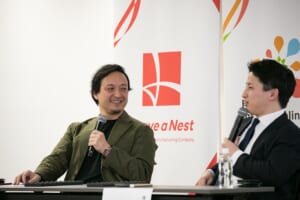
rice field in front of a temple's main hall I believe that the fastest way to solve the water problem is to create a system in which everyone can participate. Because with climate change raging around the world and water problems becoming more serious, there must be many people who want to do something about it.
suffix for names of swords, armour, musical instruments, etc. Our session partner, Aqua Clara, is working to deliver drinking water to the affected areas. This is absolutely necessary to sustain life. On the other hand, is providing showers important in terms of improving the quality of life in the affected areas?
rice field in front of a temple's main hall Of course there is the need for hygiene, but I was impressed when the principal of a school used as an evacuation center said, "This is human dignity. It is hard to not be able to take a bath for weeks and be forced to worry about body odors and other problems. However, while drinking water is about 3 liters per day, 250 to 300 liters of water is needed for daily use, and when water is used, wastewater is also produced for that amount. Because of these circumstances, it has been difficult to provide showers until now.
Seeing weeds in the affected area gave me an idea.
suffix for names of swords, armour, musical instruments, etc. Now, what is next after water? Baba, please help us.
Yasunori Baba, Research Institute for Environmental Microbiology What inspired me to develop a small methane fermentation system was my own experience in the disaster. When I was a student, I experienced the Great East Japan Earthquake and spent some time in an evacuation center. There was no hot food, no light, and my cell phone ran out of charge so quickly that I could not get in touch with my family. Even in such an environment, only weeds were growing. Looking at them, I thought to myself, "If only I could make methane gas from these weeds, I could use a generator and a stove.
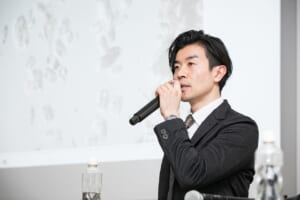
Mr. Yasunori Baba, President, Environmental Microbiology Laboratory Co. Lecturer, Institute of Bioresource Engineering, Ishikawa Prefectural University. D. in Agriculture. D. in research on a novel methane fermentation method using bovine rumen microorganisms, and based on his experience of living through the Great East Japan Earthquake in 2011, he has been conducting research to produce methane gas, which is city gas, and electricity from weeds that exist anywhere and anytime, so that people can eat, drink, and use electricity even in times of disaster with gas outages. He is currently conducting research to make it possible to eat, drink, and use electricity even in times of disaster. In August 2022, he established Environmental Microbiology Research Institute, Inc. and is working on the commercialization of a resource-recycling power generation system with disaster response capabilities.
We started our research from there, but weeds have plant cell walls, so ordinary methanogens cannot break them down. So, we turned our attention to the stomachs of cows, which are always eating grass. The stomach of a cow, called the rumen, holds many microorganisms that dissolve weeds. We took these microorganisms and cultivated them in an artificial tank to develop a system to produce gas and electricity from weeds.
This system was finally completed 12 years after the Great East Japan Earthquake. We named the system "Eco-Standalone," meaning that even in the event of a disaster, the system can be self-sustaining, producing gas and electricity by fermenting weeds and vegetable scraps. The device is labeled "GEP (Gep) Solution.
venue (Laughter)
horse-riding ground The acronym is a combination of the word "Geb" for cow and "Green Energy Production". When weeds are thrown in from the top of the device, methane bacteria produce gas in an adjacent tank. The gas can be used for cooking by connecting it to a gas stove or stored by connecting it to a generator.
This system is currently in operation at a shopping center in Ishikawa Prefecture. Here, more than 100 kg of vegetable scraps are generated per day, which are broken down to produce gas to generate electricity, which is used to charge tablets used for inventory control and other purposes. When disaster strikes, this will be a place to serve as a local disaster prevention center, serving food and providing recharging for smartphones.
When the Noto Peninsula earthquake hit on New Year's Day, we consulted with the appropriate authorities about whether we could take a small version of the Eco Standalone to Noto. However, we found that small support would be a nuisance because of the priority given to truck transportation by the Self-Defense Forces. In other words, if we are not operating at that location during normal times, we will not be of any use when disaster strikes. In the future, we would like to introduce this system to more supermarkets in each region to realize a situation where the trucks are properly located at the time of a disaster.
Finally, we will discuss the use of fermentation residues. When vegetable scraps are fermented, methane gas is released and a liquid remains. When we used it as liquid fertilizer in rice paddies, the yield was almost the same as that of rice paddies sown with chemical fertilizer. I like beer, so they used it as a fertilizer for beer hops, which we jointly developed with a local brewery and marketed under the name "Disaster Prevention Beer.
On the jacket of the Disaster Prevention Beer, there is a picture of a boy picking weeds and handing them to his grandfather. Behind the grandfather is a "GEP". He is putting weeds in there to make gas and giving the boy a hot curry made with the gas. Beside him, lights are being lit with methane gas and smart phones are being charged with electricity made from medan gas. This is the kind of future we want to realize.
rice field in front of a temple's main hall How many kilograms of weeds can produce about kW of electricity?
horse-riding ground The prototype can generate roughly 1 kW of electricity from 10 kg dry weight raw material. Currently, lab tests have yielded methane gas that can generate up to 7 kW from 10 kg dry weight raw material.
rice field in front of a temple's main hall Well, that sounds very realistic.
suffix for names of swords, armour, musical instruments, etc. Weeds often grow overgrown at the site of a disaster. But it is quite difficult to cut weeds, isn't it? It would be nice if we could mechanize the process, for example by introducing robots. Or substitute soil or something else that is easy to collect.
horse-riding ground Carbon and hydrogen can be substituted for other things. However, if the material is hard, such as wood, the microorganisms cannot break it down.
suffix for names of swords, armour, musical instruments, etc. What about excrement?
horse-riding ground It is all right. As a matter of fact, I consulted the appropriate authorities when I saw the lack of progress in excrement disposal after the Noto Peninsula earthquake. At that time, I was asked what to do with the liquid that comes out after the excrement has fermented. I suggested that we dig up the soil and bury it, but that was not an option. I wish there was a system that could decompose and process human excrement using the action of microorganisms, like a bio-toilet.
Use containers that can be transported by private vehicles as shelters.
suffix for names of swords, armour, musical instruments, etc. What you just said is going to lead to the next Mr. Yoshioka. Thank you for your patience, Mr. Yoshioka. Please give me your best regards.
Takeshi Yoshioka, Shibaura Institute of Technology and University of Tokyo Hello, my name is Yoshioka. I always start my self-introduction by saying that I am a Carp fan despite being born and raised in Hyogo Prefecture (laughs). My specialty is energy, and although my title is affiliated with a university, I also run a private environmental consulting firm. I have one foot in both industry and academia and hope to bridge the gap between the two.
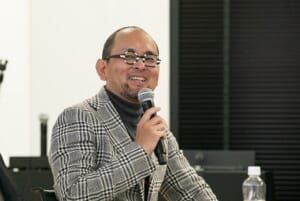
Tsuyoshi Yoshioka, Project Professor, Department of Environmental Systems, School of Systems Science and Engineering, Shibaura Institute of Technology / Project Researcher, Matsuhashi Laboratory, Department of Electrical Engineering, Graduate School of Engineering, The University of Tokyo Born in Hyogo Prefecture in 1975. After graduating from the Department of Mechanical Engineering, Faculty of Engineering Science, Osaka University, he joined a construction consulting firm, where he was engaged in facility design and work related to new energy and energy conservation for the national and local governments. He later completed his master's and doctoral studies (Environmental Systems) at the Graduate School of Frontier Sciences, University of Tokyo, where he earned his doctorate (Environmental Studies). In graduate school, he studied risk analysis of energy projects and investment strategies using financial engineering methods. He has been engaged in research and studies on renewable energy and energy conservation, as well as policy support for national and local governments, and has been involved in supporting the start-up and development of energy projects in local communities and fundraising (planning and structuring citizen investments, etc.).
One that is gaining momentum right now is the Ministry of the Environment's "Decarbonization Leading Regions," in which I am a member of the evaluation committee that will select 100 regions across the country with plans to decarbonize civilian electricity in targeted areas by FY2030. Resilience is still a key word in this process.
Looking back on my career, I studied mechanical engineering at university and worked as a construction consultant. Later, I was able to receive work in renewable energy, which I had always wanted to work on, and my knowledge as an engineer was no longer enough. For example, in wind power generation, I was in charge of analyzing wind conditions and designing power generation systems, but as the project progressed, various issues emerged, such as financing and building consensus with local residents. So I re-entered graduate school to study environmental economics and finance, and while working on the project, I also gained knowledge of human resource development and sociology for consensus building.
Renewable energy projects face a variety of risks, including natural uncertainties, institutional and local opposition. We were researching how to deal with these risks, when to invest, and when to expand or even scale back or withdraw.
As a case study, let me introduce an offshore windmill in Denmark that was built around 2000. The project was located near a villa area, and at first the developer proposed to put many wind turbines in two rows, which caused opposition in the local community. After repeated dialogues with the local residents, we reviewed the design and devised a new way to arrange the windmills in a bow shape, and were able to obtain their agreement. Moreover, when the company solicited investment for the start of the project, it received a large number of investors, including many from the local community. Thus, consensus building with the local community is an important point.
Now, together with our session partner, Aqua Clara, we are working on the development of a small container called BLOCKLY. That is, it is very difficult to transport a large container to the site in the event of a disaster; BLOCKLY is 2.1m square and weighs less than 750kg. It can be transported by a private car with a regular driver's license. Normally used for shared offices, kitchen cars, glamping, etc., BLOCKLY can be converted into an evacuation facility as soon as a disaster strikes.
Starting with the first unit in Kobe, we are now planning to install a glamping-type unit in Chiba. We are also thinking of making it energy independent by putting mobile solar power and batteries together, and we plan to launch a bio-toilet using BLOCKLY around May.
The students at Mejiro University's Department of Sociology are also handling the project in an exercise class on "What kind of social problems can be solved by using BLOCKLY? The students are full of ideas, such as using it as a bath for welfare purposes, in a shelter, or in a soundproofing facility. What I found interesting was the talk about holding a mobile marché in the countryside, and I am stimulated by the various proposals.
Deep Tech Aggregation Leads to New Proposals
suffix for names of swords, armour, musical instruments, etc. Weeds are a good source of power for BLOCKLY.
horse-riding ground With weeds, it doesn't matter if it's a rainy day when the solar panels can't generate power. When I asked him about it earlier, he said that it would run on 40W, so a smaller "GEP" would be sufficient for that.
suffix for names of swords, armour, musical instruments, etc. Why not add a WOTA device there as well?
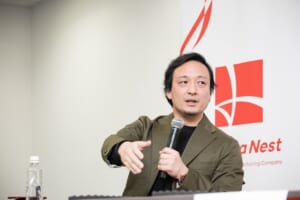
Yukihiro Maru Representative Director, Group CEO, Liverness Inc. D. in Agriculture, Graduate School of Agricultural and Life Sciences, The University of Tokyo. 2002, while still a graduate student, he founded LIVERNESS with only undergraduate and graduate students of science and engineering. He has developed Japan's first "Science Delivery Experimental Classroom" into a business. He runs a "knowledge manufacturing business" that creates new businesses by combining technologies and knowledge from different fields. As the instigator of one of Asia's largest deep tech venture ecosystems, he works to solve global issues by uncovering deep issues from around the world. He has also been involved in the launch of numerous ventures, including Euglena.
rice field in front of a temple's main hall If you can give me about 250W.
suffix for names of swords, armour, musical instruments, etc. That's good! When deep techs get together like this, new proposals are born. By the way, what kind of resilience education is there in universities now?
horse-riding ground In my lab, we have a camp using "GEP". Each time a problem comes up during the overnight stay, the students write it down on a large piece of paper. Conditions change from time to time, so we do this camp every season to improve the accuracy of the system.
suffix for names of swords, armour, musical instruments, etc. So the experience itself is an education. How about you, Mr. Yoshioka? Education at universities is one way, and education for policy makers is also necessary, such as the Ministry of the Environment's plan you mentioned earlier.
Yoshitaka At the university, we have energy-related exercises, but there is no specific education that focuses on disasters. However, since the balance between supply and demand is important for energy, I think we need to do more research to properly investigate and study the demand during normal times and during disasters.
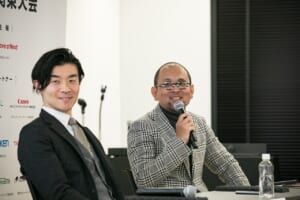
In terms of opinions to government policy makers, I always say that when considering energy infrastructure, we should take into account the future of the region and look at long-term urban development, such as mobility and a flexible system that can be used in other areas and utilize existing grids.
suffix for names of swords, armour, musical instruments, etc. Are energy infrastructure and water infrastructure and national policy makers the same?
rice field in front of a temple's main hall No, it is not.
suffix for names of swords, armour, musical instruments, etc. This is where things go wrong. People say, "Let's increase resilience" and "Let's make Japan more resilient," but the people in the water infrastructure and the people in the energy infrastructure are not talking to each other properly. This is symbolic of Japan's stove-piped society. We are probably going to have a variety of major disasters within the next 100 years. Climate change, we cannot wait. And yet, education is not being done, and budgets are not being spent effectively in each ministry. The reason why is because it is stove-piped.
Let's discuss this super interdisciplinary conference horizontally. We have researchers here who can solve problems in each field.
The "Liverness Resilience Project" was launched!
suffix for names of swords, armour, musical instruments, etc. Here today, we have assembled a dibtech on disaster management in various fields. First of all, we have met. So, what do we do from here? Let me make a presentation.
Disaster management covers a wide range of disasters. In Japan, we have earthquakes, and in the Great East Japan Earthquake, we also had a tsunami. Around the world, the definition of disasters differs from country to country, including droughts, landslides, and floods.
In contrast, it is important to envision what a society will be like after a disaster strikes. In a community, there are people with different attributes: children, elderly people, company employees, authorities, professionals, entrepreneurs, etc. What will happen to these people? What will happen to these people? Going back and forth one by one between the situation of the community personnel and the risks of food, water, logistics, etc., we need to do preparation, awareness raising, recovery planning, management, and monitoring.
However, right now in Japan, people think only in terms of water supply for water, logistics for logistics, and food for food, and there is no plan like this. With so many earthquakes and floods, we are in a situation where disaster management is necessary, yet we are lagging behind in addressing this issue. What I would like to say today is that it is time to face reality and start moving. That is to say.
For example, items to measure resilience, such as how many "WOTA BOXES" or "GEPs" a municipality has, should be created and quantified by experts like Dr. Yoshioka. Through such data, communities will share their ideas about their resilience.
In addition, all strata of society need to be educated about resilience. Knowledge should be shared and discussed in schools and all other venues. Then, key players will find ways to apply the knowledge to their own communities and take action. A community with many such key players is a resilient community.
To make this plan a reality, we are launching the LIVERNESS Resilience Project. Resilience does not only refer to disasters. For example, food security. We envision a variety of situations, such as what to do when there is a major war and food supplies stop coming in from overseas. We also need a system that allows the various people who make up society to participate, as in the case of junior high school students helping to operate WOTA in the Noto Peninsula earthquake-stricken area.
In addition to the speakers and other Japanese companies such as ACSL, a Japanese drone company, and Liberaware, a Malaysian company has offered to participate. We hope that deep-tech companies from around the world will gather and add their assets to the project to create a flexible and dynamic social infrastructure. As a private company, we would like to make this a major project by submitting proper requests to the government and obtaining budgets for research projects.
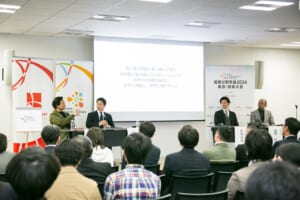
So, it is time. Let's have a final word from each of the speakers.
Yoshitaka I have always thought from an energy perspective, but after hearing about water and weeds like this today, I think that if we can turn them around together, we can make something better. I hope we can do something together, and I look forward to continuing to work with you.
horse-riding ground The term "disaster-related death" is used to describe deaths that are not directly caused by a disaster but are related to it. This term refers to deaths that are not directly caused by a disaster, but are related to subsequent events. For example, in the Great East Japan Earthquake, it is said that 90% of disaster-related deaths occurred among the elderly people aged 65 and over, who were physically weak due to the cold. If we had our equipment, we might have been able to reduce the number of disaster-related deaths by providing hot meals and warmth. We will continue to promote the spread of our system from normal times to various areas, believing that this will lead to the prevention of disaster-related deaths.
rice field in front of a temple's main hall I have been responding to disasters for almost 8 years in various areas. What I always experience there is frustration. The problems in disaster-stricken areas are things that technically could have been solved long ago. However, because of our lack of preparation, many people do not have access to the technology. So when we try to make new things for them, it inevitably takes several months. But in the affected areas, people are in trouble at the level of "we need to do something within a few days," and if we respond after the disaster has occurred, we will not be able to get there in time. Whenever I felt such frustration, I thought to myself, "I don't want to repeat this next time," and I have continued to make improvements.
Based on this experience, as Mr. Maru mentioned earlier, I think it is important to prepare for the next major disaster in this country by working backward from the goal in order to know what to do and to avoid regrets after it happens. I think it is very significant that this project is now underway.
suffix for names of swords, armour, musical instruments, etc. Thank you very much. Let's work together from now on to create a resilient community, and let's work together as a collective team from all of us at Livanes and Deep Tech to work on society. Those of you who have spoken here today, you are already key players. If you want to join us, please give us a call. Let's do this together.
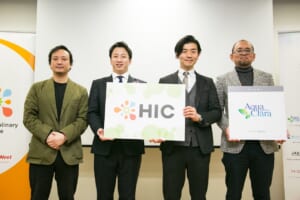
From left: Yukihiro Maru, LIBANES / Mr. Yosuke Maeda, WOTA / Mr. Yasunori Baba, Environmental Microbiology Laboratory / Mr. Tsuyoshi Yoshioka, Shibaura Institute of Technology and University of Tokyo
(Composition: Akitsuko Murotani)
